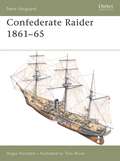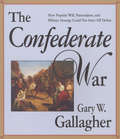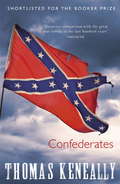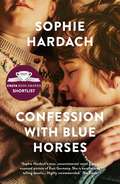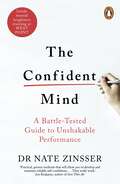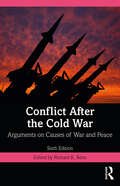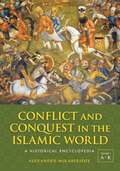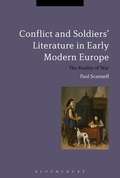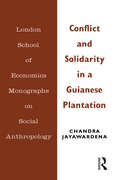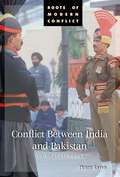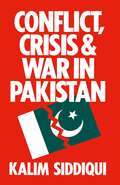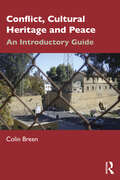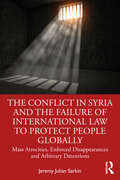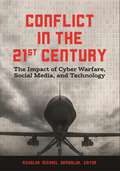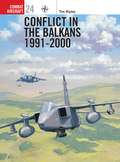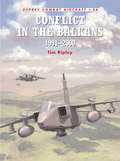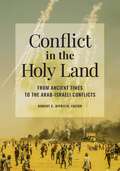- Table View
- List View
Confederate Raider 1861–65 (New Vanguard)
by Angus KonstamThe Confederate states adopted radical solutions to counter the naval superiority of their opponents. One of the more successful solutions they adopted was the use of commerce raiders. This book describes the reasons which forced the Confederates to resort to commerce raiding, and outlines the way in which these craft were converted or specially built to perform their role. It details not only the way these craft were operated and manned, but also their brutal attacks, daring escapes and climatic battles against the large numbers of Union warships forced to hunt them down.
Confederate Raider 1861–65 (New Vanguard)
by Angus KonstamThe Confederate states adopted radical solutions to counter the naval superiority of their opponents. One of the more successful solutions they adopted was the use of commerce raiders. This book describes the reasons which forced the Confederates to resort to commerce raiding, and outlines the way in which these craft were converted or specially built to perform their role. It details not only the way these craft were operated and manned, but also their brutal attacks, daring escapes and climatic battles against the large numbers of Union warships forced to hunt them down.
The Confederate War
by Gary W. GallagherIf one is to believe contemporary historians, the South never had a chance. Many allege that the Confederacy lost the Civil War because of internal division or civilian disaffection; others point to flawed military strategy or ambivalence over slavery. But, argues distinguished historian Gary Gallagher, we should not ask why the Confederacy collapsed so soon but rather how it lasted so long. In The Confederate War he reexamines the Confederate experience through the actions and words of the people who lived it to show how the home front responded to the war, endured great hardships, and assembled armies that fought with tremendous spirit and determination. Gallagher’s portrait highlights a powerful sense of Confederate patriotism and unity in the face of a determined adversary. Drawing on letters, diaries, and newspapers of the day, he shows that Southerners held not only an unflagging belief in their way of life, which sustained them to the bitter end, but also a widespread expectation of victory and a strong popular will closely attuned to military events. In fact, the army’s “offensive-defensive” strategy came remarkably close to triumph, claims Gallagher—in contrast to the many historians who believe that a more purely defensive strategy or a guerrilla resistance could have won the war for the South. To understand why the South lost, Gallagher says we need look no further than the war itself: after a long struggle that brought enormous loss of life and property, Southerners finally realized that they had been beaten on the battlefield. Gallagher’s interpretation of the Confederates and their cause boldly challenges current historical thinking and invites readers to reconsider their own conceptions of the American Civil War.
Confederates: A Novel
by Thomas KeneallyAs the Civil War tears America apart, General Stonewall Jackson leads a troop of confederate soldiers towards the battle they believe will be a conclusive victory. Through their hopes, fears and losses, Keneally searingly conveys both the drama and mundane hardship of war, and brings to life one of the most emotive episodes in American history.
Confession with Blue Horses
by Sophie HardachShortlisted for the Costa Novel Award 2019. Tobi and Ella's childhood in East Berlin is shrouded in mystery. Now adults living in London, their past is full of unanswered questions. Both remember their family's daring and terrifying attempt to escape. But what happened next? Where did their parents disappear to, and why? What happened to Heiko, their little brother? And was there ever a painting of three blue horses? In contemporary Germany, Aaron works for a Stasi archive, making his way through old files, reconstructing the tragic history of thousands of families. But one file in particular catches his eye; and soon unravelling the secrets at its heart becomes an obsession. When Ella finds a stash of her mother's notebooks, she and Tobi embark on a search that will take them back to Berlin. Her fate clashes with Aaron's, and they piece together the details of Ella's past... and a family torn apart. Devastating and beautifully written, funny and life-affirming, Confession with Blue Horses explores intimate family life and its strength in the most difficult of circumstances.
The Confident Mind: A Battle-Tested Guide to Unshakable Performance
by Nathaniel ZinsserYou don't have to be born confident. You can learn to be confident. Here's how.Dr Nate Zinsser works with the cream of the US military to prepare them mentally for leadership and for action. He also trains top sportsmen and women to develop the self-belief essential for world-class performance. Now he shares the tried and tested techniques he has perfected over many years to help anyone who wants to acquire the confidence that will enable them to perform at their very best, whatever the environment, however stressful the situation. In the process he shows how to make positive use of nervousness, what acquiring a 'success cycle' involves, and why self-assurance, like all skills, requires constant practice.Drawing on the latest research, and packed with real-life examples, this is a supremely practical - and inspirational - guide to achieving bullet-proof confidence.
Conflict: The Evolution of Warfare from 1945 to Ukraine
by null David Petraeus null Andrew RobertsTHE INTERNATIONAL BESTSELLER ‘A rigorous and thoughtful study of what has happened on battlefields over the past eight decades’ THE TIMES ‘A hugely important book … elegantly written and persuasively argued’ DAILY TELEGRAPH ** FULLY UPDATED TO INCLUDE NEW MATERIAL ON THE ISRAEL/GAZA CONFLICT ** Conflict is both a sweeping history of the evolution of warfare up to Putin’s invasion of Ukraine, and a penetrating analysis of what we must learn from the past, and anticipate in the future, in order to navigate an increasingly perilous world. In this deep and incisive study, General David Petraeus, the former CIA director who commanded the US-led coalitions in both Iraq and Afghanistan, and the prize-winning historian Andrew Roberts, explore over seventy years of conflict, drawing significant lessons and insights from their fresh analysis of the past. Petraeus and Roberts show how often critical mistakes have been repeated time and again, and explore the challenge, for statesmen and generals alike, of learning to adapt to various new weapon systems, theories and strategies. Among the conflicts examined are the Arab – Israeli wars, the Korean and Vietnam wars, the two Gulf wars, the Balkan wars in the former Yugoslavia, and both the Soviet and Coalition wars in Afghanistan, as well as guerrilla conflicts in Africa and South America. Conflict culminates with a bracing look at Putin’s disastrous invasion of Ukraine, yet another case study in the tragic results that occur when leaders refuse to learn from history, and an assessment of the nature of future warfare. Filled with sharp insight and the wisdom of experience, Conflict is not only a critical assessment of our recent past, but also an essential primer of modern warfare that provides crucial knowledge for waging battle today as well as for understanding what the decades ahead will bring.
Conflict After the Cold War: Arguments on Causes of War and Peace
by Richard K. BettsEdited by one of the most renowned scholars in the field, Richard K. Betts’s Conflict After the Cold War assembles classic and contemporary readings on enduring problems of international security. Offering broad historical and philosophical breadth, the carefully chosen and excerpted selections in this popular reader help students engage in key debates over the future of war and the new forms that violent conflict will take. Conflict After the Cold War encourages closer scrutiny of the political, economic, social, and military factors that drive war and peace. New to the Sixth Edition Eight new readings covering issues that have grown in salience since the previous edition or that present new interpretations of answers to old problems, including pieces by Robert Kagan, Edward O. Wilson, Scott D. Sagan, Robert Jervis and Jason Healey, Jacqueline L. Hazelton, Oystein Tunsjo, and Michael Beckley. Updated volume and chapter introductions and a new reading by Richard K. Betts.
Conflict After the Cold War: Arguments on Causes of War and Peace
by Richard K. BettsEdited by one of the most renowned scholars in the field, Richard K. Betts’s Conflict After the Cold War assembles classic and contemporary readings on enduring problems of international security. Offering broad historical and philosophical breadth, the carefully chosen and excerpted selections in this popular reader help students engage in key debates over the future of war and the new forms that violent conflict will take. Conflict After the Cold War encourages closer scrutiny of the political, economic, social, and military factors that drive war and peace. New to the Sixth Edition Eight new readings covering issues that have grown in salience since the previous edition or that present new interpretations of answers to old problems, including pieces by Robert Kagan, Edward O. Wilson, Scott D. Sagan, Robert Jervis and Jason Healey, Jacqueline L. Hazelton, Oystein Tunsjo, and Michael Beckley. Updated volume and chapter introductions and a new reading by Richard K. Betts.
Conflict and Conquest in the Islamic World [2 volumes] [2 volumes]: 2 volumes [2 volumes]
A reference work that thoroughly documents the extensive military history of the Islamic world between the 7th century and the present day.Military-political conflict—and the resulting factionalism, shifts in leadership, and divergent belief systems—has been a constant and crucial part of the Islamic world. In order to fully grasp the cultural, social, or political aspects of Islam in the modern world, it is necessary to comprehend the rich tapestry of Islamic history from pre-Islamic times to the present, much of which involved armed conflict.Conflict and Conquest in the Islamic World: A Historical Encyclopedia provides hundreds of entries on wars, revolutions, sieges, institutions, leaders, armies, weapons, and other aspects of wars and military life, enabling readers to understand the complex role conflict has played in Islamic life throughout history and see how Islamic warfare has evolved over the centuries. This reference work covers not only the traditional Middle Eastern regions and countries but also provides relevant historical information regarding Islam in North Africa, Central Asia, Southeastern Asia, and Oceania.
Conflict and Soldiers' Literature in Early Modern Europe: The Reality of War (Bloomsbury Studies in Military History)
by Paul ScannellIn Conflict and Soldiers' Literature in Early Modern Europe, Paul Scannell analyses the late 16th-century and early 17th-century literature of warfare through the published works of English, Welsh and Scottish soldiers. The book explores the dramatic increase in printed material on many aspects of warfare; the diversity of authors, the adaptation of existing writing traditions and the growing public interest in military affairs.There is an extensive discussion on the categorisation of soldiers, which argues that soldiers' works are under-used evidence of the developing professionalism among military leaders at various levels. Through analysis of autobiographical material, the thought process behind an individual's engagement with an army is investigated, shedding light on the relevance of significant personal factors such as religious belief and the concept of loyalty. The narratives of soldiers reveal the finer details of their experience, an enquiry that greatly assists in understanding the formidable difficulties that were faced by individuals charged with both administering an army and confronting an enemy.This book provides a reassessment of early modern warfare by viewing it from the perspective of those who experienced it directly. Paul Scannell highlights how various types of soldier viewed their commitment to war, while also considering the impact of published early modern material on domestic military capability - the 'art of war'.
Conflict and Soldiers' Literature in Early Modern Europe: The Reality of War (Bloomsbury Studies in Military History)
by Paul ScannellIn Conflict and Soldiers' Literature in Early Modern Europe, Paul Scannell analyses the late 16th-century and early 17th-century literature of warfare through the published works of English, Welsh and Scottish soldiers. The book explores the dramatic increase in printed material on many aspects of warfare; the diversity of authors, the adaptation of existing writing traditions and the growing public interest in military affairs.There is an extensive discussion on the categorisation of soldiers, which argues that soldiers' works are under-used evidence of the developing professionalism among military leaders at various levels. Through analysis of autobiographical material, the thought process behind an individual's engagement with an army is investigated, shedding light on the relevance of significant personal factors such as religious belief and the concept of loyalty. The narratives of soldiers reveal the finer details of their experience, an enquiry that greatly assists in understanding the formidable difficulties that were faced by individuals charged with both administering an army and confronting an enemy.This book provides a reassessment of early modern warfare by viewing it from the perspective of those who experienced it directly. Paul Scannell highlights how various types of soldier viewed their commitment to war, while also considering the impact of published early modern material on domestic military capability - the 'art of war'.
Conflict and Solidarity in a Guianese Plantation (LSE Monographs on Social Anthropology)
by Chandra JayawardenaThis study concerns two communities of sugar plantation labourers, the descendants of indentured immigrants from India, who live in the county of Berbice, British Guiana. The study is focused on the analysis of social conflict: the factors that cause it, the forms it takes and its social consequences.
Conflict and Solidarity in a Guianese Plantation (LSE Monographs on Social Anthropology #Vol. 25)
by Chandra JayawardenaThis study concerns two communities of sugar plantation labourers, the descendants of indentured immigrants from India, who live in the county of Berbice, British Guiana. The study is focused on the analysis of social conflict: the factors that cause it, the forms it takes and its social consequences.
Conflict Between India and Pakistan: An Encyclopedia (Roots of Modern Conflict)
by Peter LyonThis up-to-date encyclopedia examines the conflict between India and Pakistan from Independence to the present day, with an authoritative treatment that presents the issues evenhandedly and from both countries' perspectives.Tensions between India and Pakistan are deeply rooted. Many go back to 1947 or earlier, when, with the partitioning of the provinces of Punjab and Bengal, British India was succeeded by two independent countries: a primarily Hindu India and a Muslim Pakistan. Subsequently, the two countries have fought three wars and come close to open war several other times, especially over Kashmir.Conflict Between India and Pakistan begins with a discussion of the partition of India and those who figured prominently in it, notably: Mohammed Ali Jinnah, Clem Attlee, the last viceroy, Admiral Louis Mountbatten, and Jawaharlal Nehru. Then, in a series of evenhanded, carefully crafted portraits, it describes the people, political parties, foreign and domestic policies, and economic, religious, and cultural pressures that have played a role in the conflicts between these nations from 1947 to the present.
Conflict, Cultural Heritage and Peace: An Introductory Guide
by Colin BreenConflict, Cultural Heritage and Peace offers a series of conceptual and applied frameworks to help understand the role cultural heritage plays within conflict and the potential it has to contribute to positive peacebuilding and sustainable development in post-conflict societies. Designed as a resource guide, this general volume introduces the multiple roles cultural heritage plays through the conflict cycle from its onset, subsequent escalation and through to resolution and recovery. In its broadest sense, it questions what role cultural heritage plays within conflict, how cultural heritage is used in the construction and justification of conflict narratives, how are these narratives framed and often manipulated to support particular perspectives, and how we can develop better understandings of cultural heritage and work towards the better protection of cultural heritage resources during conflict. It moves beyond the protection paradigm and recognises that cultural heritage can contribute to building peace and reconciliation in post-conflict environments. The study offers a conceptual and operational framework to understand the roles cultural heritage plays within conflict cycles, how it can be targeted during war, and the potential cultural heritage has in positive peacebuilding across the conflict lifecycle. Conflict, Cultural Heritage, and Peace offers an invaluable introduction to cultural heritage at all stages in conflict scenarios which will benefit students, researchers and practitioners in the field of heritage, environment, peace and conflict studies.
Conflict, Cultural Heritage and Peace: An Introductory Guide
by Colin BreenConflict, Cultural Heritage and Peace offers a series of conceptual and applied frameworks to help understand the role cultural heritage plays within conflict and the potential it has to contribute to positive peacebuilding and sustainable development in post-conflict societies. Designed as a resource guide, this general volume introduces the multiple roles cultural heritage plays through the conflict cycle from its onset, subsequent escalation and through to resolution and recovery. In its broadest sense, it questions what role cultural heritage plays within conflict, how cultural heritage is used in the construction and justification of conflict narratives, how are these narratives framed and often manipulated to support particular perspectives, and how we can develop better understandings of cultural heritage and work towards the better protection of cultural heritage resources during conflict. It moves beyond the protection paradigm and recognises that cultural heritage can contribute to building peace and reconciliation in post-conflict environments. The study offers a conceptual and operational framework to understand the roles cultural heritage plays within conflict cycles, how it can be targeted during war, and the potential cultural heritage has in positive peacebuilding across the conflict lifecycle. Conflict, Cultural Heritage, and Peace offers an invaluable introduction to cultural heritage at all stages in conflict scenarios which will benefit students, researchers and practitioners in the field of heritage, environment, peace and conflict studies.
The Conflict in Syria and the Failure of International Law to Protect People Globally: Mass Atrocities, Enforced Disappearances and Arbitrary Detentions
by Jeremy Julian SarkinThis book explores, through the lens of the conflict in Syria, why international law and the United Nations have failed to halt conflict and massive human rights violations in many places around the world which has allowed tens of millions of people to be killed and hundreds of millions more to be harmed. The work presents a critical socio-legal analysis of the failures of international law and the United Nations (UN) to deal with mass atrocities and conflict. It argues that international law, in the way it is set up and operates, falls short in dealing with these issues in many respects. The argument is that international law is state-centred rather than victim-friendly, is, to some extent, outdated, is vague and often difficult to understand and, therefore, at times, hard to apply. While various accountability processes have come to the fore recently, processes do not exist to assist individual victims while the conflict occurs or the abuses are being perpetrated. The book focuses on the problems of international law and the UN and, in the context of the many enforced disappearances and arbitrary detentions in Syria, why nothing has been done to deal with a rogue state that has regularly violated international law. It examines why the responsibility to protect (R2P) has not been applied and why it ought to be used, generally, and in Syria. It uses the Syrian context to evaluate the weaknesses of the system and why reform is needed. It examines the UN institutional mechanisms, the role they play and why a civilian protection system is needed. It examines what mechanism ought to be set up to deal with the possible one million people who have been disappeared and detained in Syria. The book will be a valuable resource for students, academics and policy-makers working in the areas of public international law, international human rights law, political science and peace and security studies.
The Conflict in Syria and the Failure of International Law to Protect People Globally: Mass Atrocities, Enforced Disappearances and Arbitrary Detentions
by Jeremy Julian SarkinThis book explores, through the lens of the conflict in Syria, why international law and the United Nations have failed to halt conflict and massive human rights violations in many places around the world which has allowed tens of millions of people to be killed and hundreds of millions more to be harmed. The work presents a critical socio-legal analysis of the failures of international law and the United Nations (UN) to deal with mass atrocities and conflict. It argues that international law, in the way it is set up and operates, falls short in dealing with these issues in many respects. The argument is that international law is state-centred rather than victim-friendly, is, to some extent, outdated, is vague and often difficult to understand and, therefore, at times, hard to apply. While various accountability processes have come to the fore recently, processes do not exist to assist individual victims while the conflict occurs or the abuses are being perpetrated. The book focuses on the problems of international law and the UN and, in the context of the many enforced disappearances and arbitrary detentions in Syria, why nothing has been done to deal with a rogue state that has regularly violated international law. It examines why the responsibility to protect (R2P) has not been applied and why it ought to be used, generally, and in Syria. It uses the Syrian context to evaluate the weaknesses of the system and why reform is needed. It examines the UN institutional mechanisms, the role they play and why a civilian protection system is needed. It examines what mechanism ought to be set up to deal with the possible one million people who have been disappeared and detained in Syria. The book will be a valuable resource for students, academics and policy-makers working in the areas of public international law, international human rights law, political science and peace and security studies.
Conflict in the 21st Century: The Impact of Cyber Warfare, Social Media, and Technology
by Nicholas Michael SambalukThis reference work examines how sophisticated cyber-attacks and innovative use of social media have changed conflict in the digital realm, while new military technologies such as drones and robotic weaponry continue to have an impact on modern warfare.Cyber warfare, social media, and the latest military weapons are transforming the character of modern conflicts. This book explains how, through overview essays written by an award-winning author of military history and technology topics; in addition to more than 200 entries dealing with specific examples of digital and physical technologies, categorized by their relationship to cyber warfare, social media, and physical technology areas. Individually, these technologies are having a profound impact on modern conflicts; cumulatively, they are dynamically transforming the character of conflicts in the modern world.The book begins with a comprehensive overview essay on cyber warfare and a large section of A–Z reference entries related to this topic. The same detailed coverage is given to both social media and technology as they relate to conflict in the 21st century. Each of the three sections also includes an expansive bibliography that serves as a gateway for further research on these topics. The book ends with a detailed chronology that helps readers place all the key events in these areas.
Conflict in the 21st Century: The Impact of Cyber Warfare, Social Media, and Technology
by Nicholas Michael SambalukThis reference work examines how sophisticated cyber-attacks and innovative use of social media have changed conflict in the digital realm, while new military technologies such as drones and robotic weaponry continue to have an impact on modern warfare.Cyber warfare, social media, and the latest military weapons are transforming the character of modern conflicts. This book explains how, through overview essays written by an award-winning author of military history and technology topics; in addition to more than 200 entries dealing with specific examples of digital and physical technologies, categorized by their relationship to cyber warfare, social media, and physical technology areas. Individually, these technologies are having a profound impact on modern conflicts; cumulatively, they are dynamically transforming the character of conflicts in the modern world.The book begins with a comprehensive overview essay on cyber warfare and a large section of A–Z reference entries related to this topic. The same detailed coverage is given to both social media and technology as they relate to conflict in the 21st century. Each of the three sections also includes an expansive bibliography that serves as a gateway for further research on these topics. The book ends with a detailed chronology that helps readers place all the key events in these areas.
Conflict in the Balkans 1991–2000 (Combat Aircraft)
by Mark Rolfe Tim RipleyExposing the true scale and significance of the deployment of air power in the Balkans, this book details the activities of NATO and UN aircraft as well as local pilots in the former Yugoslavia. From bombing by B-2 stealth bombers to air-to-air combat; from moving ground troops by helicopter to 'food-bombing' for refugees, air power has played a vital role in 'Europe's Vietnam', and there is little sign that the fires of conflict are being extinguished. Debate amongst air power practitioners has yielded little agreement as to the degree of damage inflicted on the Yugoslav 3rd Army in Kosovo, the Balkans continue to be a region of conflict and ethnic hatred.
Conflict in the Balkans 1991–2000 (Combat Aircraft #24)
by Mark Rolfe Tim RipleyExposing the true scale and significance of the deployment of air power in the Balkans, this book details the activities of NATO and UN aircraft as well as local pilots in the former Yugoslavia. From bombing by B-2 stealth bombers to air-to-air combat; from moving ground troops by helicopter to 'food-bombing' for refugees, air power has played a vital role in 'Europe's Vietnam', and there is little sign that the fires of conflict are being extinguished. Debate amongst air power practitioners has yielded little agreement as to the degree of damage inflicted on the Yugoslav 3rd Army in Kosovo, the Balkans continue to be a region of conflict and ethnic hatred.
Conflict in the Holy Land: From Ancient Times to the Arab-Israeli Conflicts
by Robert C. DiPrizioWith more than 250 cross-referenced entries covering every aspect of conflict in the Holy Land, this illuminating book will help students understand the volatile history of Palestine and Israel and its impact on the rest of the world.Palestine is considered a sacred land by Christians, Jews, and Muslims. This has contributed to the violence that has ravaged the Holy Land throughout its long history. This A–Z reference work, which defines the Holy Land as historic Palestine (the combined territories of Israel, the West Bank, and the Gaza Strip), covers such ancient conflicts as Egypt's rule over Canaan, the reign of King David, and the Jewish Revolts against the Roman Empire. In addition, the title includes detailed entries on such medieval conflicts as the Crusades and such contemporary conflicts as the Arab-Israeli wars.The reference begins with an introduction that provides readers with the necessary context to understand the region's bloody history and a comprehensive chronology that will help students construct a more complete picture of conflict in the Holy Land. Then come hundreds of key entries on the events, individuals, groups, places, and ideologies that have played an important role in the strife there. The title concludes with an expansive bibliography that will aid students looking to do more research on the topic and a thorough index.
